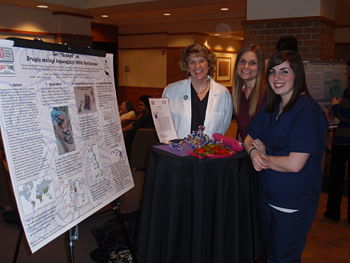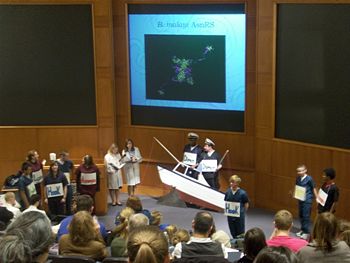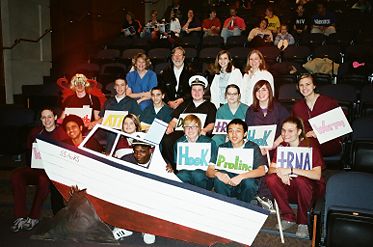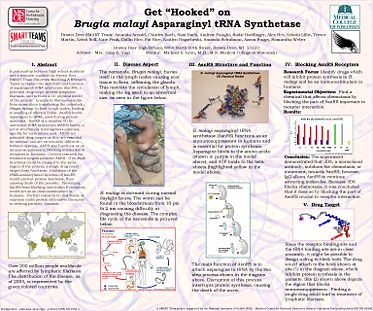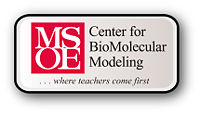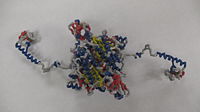User:Gina Vogt/Get "Hooked" on Brugia malayi Asparaginyl tRNA Synthetase.
From Proteopedia
Contents |
A SMART Team Molecular Story --- from the Brown Deer High School 2008-2009 SMART Team
Students: Amanda Arnold, Charles Bach, Sam Bach, Andrew Faught, Sadie Haeflinger, Alex Her, Kristin Lillie, Trevor Martin, Kristi Noll, Kate Peak, Collin Rice, Pat Rice, Kaitlyn Rogacheski, Amanda Schulman, Aaron Suggs, Samantha Weber
Advisor: Mrs. Gina R. Vogt
Mentors: Michael A. Kron, M.D., M.S. Medical College of Wisconsin
Abstract
A partnership between high school students and a scientist enabled the Brown Deer SMART Team (Students Modeling A Research Topic) to explore the structure and function of asparaginyl-tRNA synthetase (AsnRS), a potential drug target to treat lymphatic filariasis, and to build a 3D physical model of the protein. Lymphatic filariasis results from mosquitoes transferring the nematode, Brugia malayi, to host lymph nodes, leading to swelling of affected limbs. AsnRS hooks asparagine to tRNA, used during protein synthesis. AsnRS is a member of the aminoacyl tRNA synthetase (AARS) family, a set of structurally heterogenous enzymes, specific for each amino acid. AARS are potential drug targets as they are essential for survival and are structurally different between species. AARS also functions as an immunosuppressant, blocking interleukin 8 receptors in humans. Current research for treatment targets parasitic AARS. If multiple functions could be mapped to the same region of the protein, a single drug could target these functions. Inhibition of the tRNA-aminocylation function of AsnRS would prevent protein synthesis, thus causing death of the parasite. Preventing AsnRS from blocking interleukin 8 receptors, would act as an immunostimulant in humans. Further research on this family of enzymes could provide alternative therapies to treating parasitic diseases.
Creating the Physical Model of B. malayi AsnRS
References
1) Sai Chetan K. Sukuru, Thibaut Crepin, Youli Milev, Liesl C. Marsh, Jonathan B. Hill, Regan J. Anderson, Jonathan C. Morris, Anjali Rohatgi, Gavin O'Mahony, Morten Grøtli, Franck Danel, Malcolm G. P. Page, Michael Härtlein, Stephen Cusack, Michael A. Kron, and Leslie A. Kuhn. 2006. "Discovering new classes of Brugia malayi asparaginyl-tRNA synthetase inhibitors and relating specificity to conformational change" J Comput Aided Mol Des 20, 159-178.
2) Michael A. Kron, Sam Cichanowicz, Angela Hendrick, Aizhuo Liu, Joseph Leykam, and Leslie A. Kuhn. 2008. "Using structural analysis to generate parasite-selective monoclonal antibodies" Protein Science 17, 983-989.
3) M. A. Kron, L. A. Kuhn, P. C. Sanschagrin, M. Hartlein, Morten Grotli, and S. Cusack. 2003. "Strategies for Antifilarial Drug Development" Journal of Parasitology 89, S226-S235.
4) Michael Kron and Michael Härtlein. The Aminoacyl-tRNA Synthetases. Georgetown, Texas: Eurekah, 2005.
Poster and Presentation
We were able to present our project, poster, and our physical models at the 2009 American Society for Biochemistry and Molecular Biology convention in New Orleans, LA. The poster was presented at the Medical College of Wisconsin and at the New Orleans Convention Center.
MSOE Center for BioMolecular Modeling and SMART Teams
SMART Teams (Students Modeling A Research Topic) is a science outreach program developed by the MSOE Center for BioMolecular Modeling. In this program, teams of high school students work with a local resarch lab to design and build a physical model of a protein that is being investigated by the lab. The goal of the SMART Team program is to introduce students to the real world of science --- as it exists in a local research lab. The development of this program was supported by grants from the NIH-NCRR SEPA program (Science Education Partnership Award) and an HHMI Precollege Science Education Award. For more information about this program, visit the SMART Teams Proteopedia home page or visit the CBM web site at www.rpc.msoe.edu/cbm.
